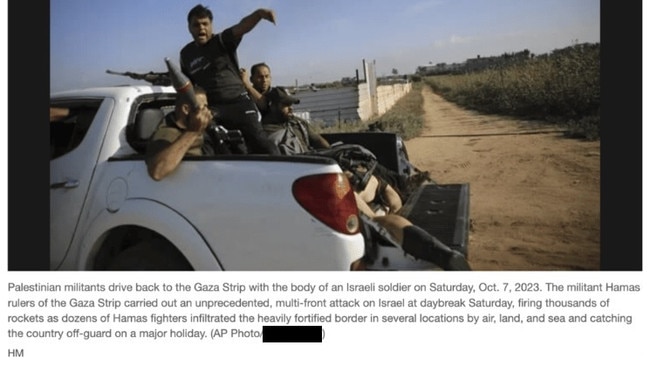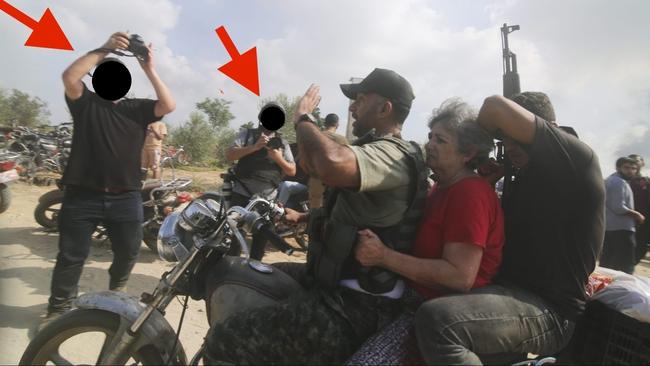Israel demands answers from AP, Reuters, CNN, NYT over presence of photographers on October 7
“Serious questions” are being raised about the horrific October 7 attacks on Israel, with details in these photos leading to a disturbing claim.

Media
Don't miss out on the headlines from Media. Followed categories will be added to My News.
A pro-Israel media watchdog has raised questions about the presence of photographers working for some of the world’s biggest news organisations on the morning Hamas launched the bloody October 7 terror attacks.
Four photographers working for The Associated Press (AP) and two working for Reuters were at the border with Gaza in time to document the invasion by Hamas terrorists that left some 1400 dead and 240 kidnapped, according to an article published on Wednesday by the Honest Reporting group.
The US-Israeli watchdog questioned whether the Gaza-based photographers had foreknowledge of attacks, arguing use of their work by major international media outlets raised “serious ethical questions”.
“What were they doing there so early on what would ordinarily have been a quiet Saturday morning?” Honest Reporting wrote.


“Did the respectable wire services, which published their photos, approve of their presence inside enemy territory, together with the terrorist infiltrators? Did the photojournalists who freelance for other media, like CNN and The New York Times, notify these outlets? Judging from the pictures of lynching, kidnapping and storming of an Israeli kibbutz, it seems like the border has been breached not only physically, but also journalistically.”
Four names appear on AP’s photo credits from the Israel-Gaza border on October 7.
AP appears to have since removed some of the photographers’ names from its captions.
الصØÙÙŠ Øسن Ø§ØµÙ„ÙŠØ Ù‚Ø±Ø¨ آلية عسكرية تابعة للاØتلال: "اختطا٠كل الجنود الإسرائيليين الذين تواجدوا ÙÙŠ الدبابة". pic.twitter.com/ru5dmi0Pzy
— وكالة شهاب للأنباء (@ShehabAgency) October 7, 2023
As the attacks were unfolding, one of the AP’s freelancers, Hassan Eslaiah, crossed into Israel and took photos and video of a burning Israeli tank, writing in Arabic in the since-deleted video’s caption on X, “Live from inside the Gaza Strip settlements.”
A resurfaced image on social media shows Eslaiah getting a kiss on the cheek from Hamas leader Yahya Sinwar.
Sinwar, 61, dubbed Israel’s most wanted and called a “dead man walking” by Israeli Prime Minister Benjamin Netanyahu, is accused of orchestrating the October 7 massacre alongside Mohammed Deif, the head of Hamas’ military wing, the al-Qassam Brigades.

Reuters also published images from two photojournalists “who also happened to be at the border just in time for Hamas’ infiltration”, Honest Reporting wrote.
There is no suggestion that any of the photographers took part in any of the activities they were photographing, nor that they are affiliated or associated with Hamas.
Honest Reporting’s article said two of AP’s photographers were both “positioned to get pictures of the horrific abductions of Israelis into Gaza”.
Among the harrowing photos was an image of German-Israeli tattoo artist Shani Louk, 23, her legs visible on the bed of a white pick-up truck as she was taken back to Gaza after being kidnapped from the Nova music festival.
The caption of the AP photo incorrectly describes Ms Louk as “an Israeli soldier”.

Widely-circulated video later showed Hamas fighters parading Ms Louk’s naked and badly brutalised body on the back of the same truck through Gaza. Israeli officials late last month declared Ms Louk dead, after finding a fragment of her skull during operations inside Gaza.
Honest Reporting said while news agencies “may claim that these people were just doing their job”, it was “not that simple”.
“Is it conceivable to assume that ‘journalists’ just happened to appear early in the morning at the border?” it said.
“Even if they didn’t know the exact details of what was going to happen, once it unfolded did they not realise they were breaching a border? And if so, did they notify the news agencies? Some sort of communication was undoubtedly necessary – before, after or during the attack – in order to get the photos published.”
×ž×—×‘×œ×™× ×‘×ª×—×¤×•×©×ª של ×¢×™×ª×•× ××™×?
— 🇮🇱שלמה קרעי - Shlomo Karhi (@shlomo_karhi) November 9, 2023
דרשתי הבהרות מיידיות מגופי התקשורת ×”×‘×™× "ל שפורסמו בתחקיר.
כל מי שהשתתף, תמך ×ו שמר על קשר של שתיקה ו×יפשר ×ת הטבח בעוטף, ×“×™× ×• כמו כל מחבל בעזה.@CNN@Rueters@nytimes@APpic.twitter.com/WQ3kq3dTg1
The piece has caused a stir in Israel, and the government on Thursday wrote to four foreign news organisations seeking clarification regarding the behaviour of the photographers.
“It has come to our attention that certain individuals within your organization, including photographers and others, had prior knowledge of these horrific actions and may have maintained a troubling connection with the perpetrators,” Communications Minister Shlomo Karhi wrote in the letter addressed to AP, Reuters, CNN and The New York Times shared on X.

News outlets hit back
All four news organisations categorically denied the claims.
The Associated Press said in an emailed statement that “AP uses images taken by freelancers around the world, including in Gaza”.
“Hassan Eslaiah has been an occasional freelancer for AP and other news organisations,” a spokeswoman said.
“The Associated Press had no knowledge of the October 7 attacks before they happened. The role of the AP is to gather information on breaking news events around the world, wherever they happen, even when those events are horrific and cause mass casualties.”
Reuters said it was “aware of a report by Honest Reporting and accusations made against two freelance photographers who contributed to Reuters’ coverage of the October 7 attack”.
“Reuters categorically denies that it had prior knowledge of the attack or that we embedded journalists with Hamas on October 7,” a spokeswoman said.
“Reuters acquired photographs from two Gaza-based freelance photographers who were at the border on October 7, with whom it did not have a prior relationship. The photographs published by Reuters were taken two hours after Hamas fired rockets across southern Israel and more than 45 minutes after Israel said gunmen had crossed the border.”
She added, “Reuters staff journalists were not on the ground at the locations referred to in the Honest Reporting article. Reuters is committed to delivering independent, accurate and unbiased news around the world.”
The New York Times also hit back at the claims.
“The accusation that anyone at The New York Times had advance knowledge of the Hamas attacks or accompanied Hamas terrorists during the attacks is untrue and outrageous,” it said in a statement.
“It is reckless to make such allegations, putting our journalists on the ground in Israel and Gaza at risk. The Times has extensively covered the October 7 attacks and the war with fairness, impartiality, and an abiding understanding of the complexities of the conflict.”
While its photographer named in the Honest Reporting article “was not working for The Times on the day of the attack, he has since done important work for us”.
“There is no evidence for Honest Reporting’s insinuations,” the newspaper said. “Our review of his work shows that he was doing what photojournalists always do during major news events, documenting the tragedy as it unfolded.”
CNN also stressed “we had no prior knowledge of the October 7 attacks”.
“Hassan Eslaiah, who was a freelance journalist working for us and many other outlets, was not working for the network on October 7,” the network said.
“As of today, we have severed all ties with him.”
![‘What were [the photographers] doing there so early?’ Picture: AP/Screenshot](https://content.api.news/v3/images/bin/eb7fc01491f938b6145c9caf28f67d69?width=650)
It’s not the first time questions have been raised about western media outlets’ relationship with Gaza-based journalists and photographers.
The New York Times last month rehired a reporter who previously came under fire for praising Adolf Hitler in multiple resurfaced Facebook posts.
Palestinian filmmaker Soliman Hijjy hailed the “great” Nazi leader as recently as 2018 in a post on Facebook, the NY Post reported.
But The Times rehired Hijjy to cover the latest conflict.
A spokesperson for the newspaper defended the decision, telling The Post it had “reviewed problematic social media posts by Mr Hijjy when they first came to light in 2022 and took a variety of actions to ensure he understood our concerns and could adhere to our standards if he wished to do freelance work for us in the future”.
“Mr Hijjy followed those steps and has maintained high journalistic standards,” the spokesperson said. “He has delivered important and impartial work at great personal risk in Gaza during this conflict.”
In 2021, AP expressed outrage after the Gaza Strip building housing its offices there was destroyed in an Israeli air strike.
The Israeli military claimed the 12-storey al-Jalaa Tower, which also hosted Al Jazeera offices, was being used by Hamas.
AP said at the time it had “no indication Hamas was in the building or active in the building”.
But Matti Friedman, a journalist and editor who worked in AP’s Jerusalem bureau from 2006 to 2011, contradicted his former employer, saying he had heard from “a friend who is intimately familiar with military decision-making” that “there were indeed Hamas offices there”.
Friedman previously claimed in a 2014 essay for The Atlantic that AP staff in Gaza City would “witness a rocket launch right beside their office, endangering reporters and other civilians nearby – and the AP wouldn’t report it”.
He also alleged Hamas terrorists would regularly “burst into the AP’s Gaza bureau and threaten the staff – and the AP wouldn’t report it”.
AP denied Friedman’s claims in a 2014 statement, saying “his arguments have been filled with distortions, half-truths and inaccuracies, both about the recent Gaza war and more distant events”.
“His suggestion of AP bias against Israel is false,” the statement said.
Originally published as Israel demands answers from AP, Reuters, CNN, NYT over presence of photographers on October 7




